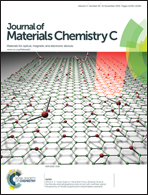Efficient multicolor and white light emission from Zr-based MOF composites: spectral and dynamic properties†
Abstract
We report on the spectroscopy and dynamics of a Zr-naphthalene dicarboxylic acid (Zr-NDC) MOF interacting with three laser dyes: Coumarin 153 (C153), Nile Red (NR) and 4-(dicyanomethylene)-2-methyl-6-(4-dimethylaminostyryl)-4H-pyran (DCM) in diethyl ether (DE) suspensions. The photoexcitation of the MOF forming the composites (dyes@MOF) leads to an energy transfer (ET) to the trapped dyes, opening the door to tune the material emission. Trapped C153 molecules exhibit two different ET dynamics. At lower C153 concentrations, the mean ET time process (from MOF monomers) is ∼3.3 ns, whereas at higher ones it is ∼360 ps. These mean ET times, which are guest-concentration dependent, reflect the different dye occupancies in the MOF pores. For trapped NR and DCM molecules, because of a different emission (energy donor) and absorption (energy acceptor) spectral overlap, the ET takes place from the excimers and not from the monomers. Solvent suspensions of the Zr-NDC MOF trapping these three dyes show multicolor and white light emission, having quantum yields of up to 41%. More specifically, NR/C153@Zr-NDC in diethyl ether suspension gives three emission bands having their intensity maxima at ∼385, ∼500 and ∼660 nm. This combination produces a white light, having CIE coordinates (0.32, 0.34) very close to the ideal ones (0.33, 0.33). Our findings open the door to develop fluorescent nanomaterial sensors and white light LEDs based on the Zr-NDC MOF.


 Please wait while we load your content...
Please wait while we load your content...